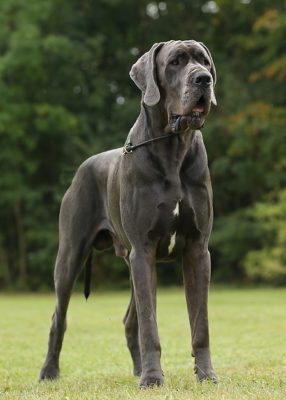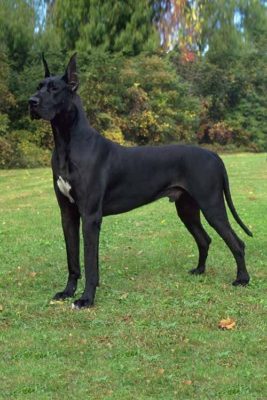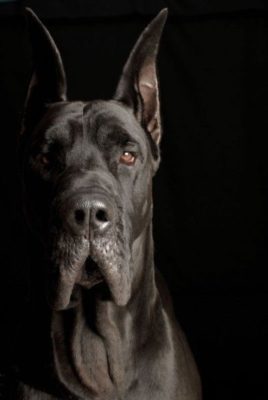Great Dane
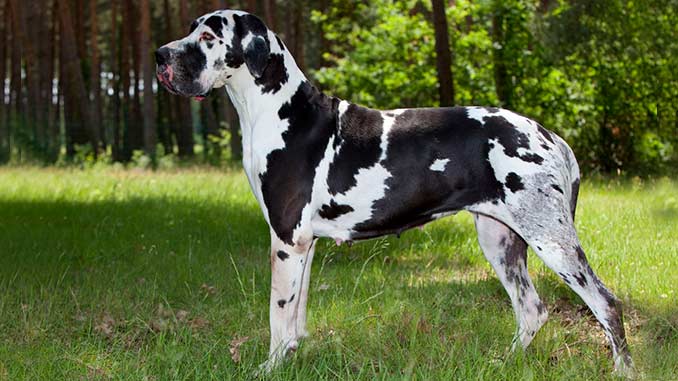
The Great Dane is the most loyal and helpful companion. Its noble manners and composed demeanor show how much it is ready to support its master and serve him as a companion in any matter. The dog is good-natured and friendly. Any member of the family, including children, can find a common language with him. But it is not recommended to leave the child and the Dane unattended because of the pet’s large size. Injury can occur not intentionally but while playing because the dog is oversized.
Table of Contents
Breed Information
| Another Name | German Mastiff, German Boarhound |
| Origin | Germany |
| Height | Males 76-90 cm Females 71-84 cm |
| Weight | 55-90 kg |
| Fur | Short |
| Color | Pale, tiger, marbled, gray-marbled, cloak, black, platten, blue, red-marbled, porcelain |
| Lifespan | 8-10 years |
| FCI Classification | Pinscher and Schnauzer – Molossoid and Swiss Mountain and Cattledogs |
| Group | Dogs for protection (guard dogs) |
| Price | From $800 |
Breed Photos
Origin History
One of the largest and largest dogs is the Great Dane, known to the world for its incredible size. From the breed’s name, it is easy to guess that the home of origin is Germany. It is not for nothing that the species is considered a giant, because according to the generally accepted standard, the height of the male dog can reach 90 cm.
If we talk about the species’ designation, initially, the word “Great Dane” did not refer to any particular breed. This name was given to all dogs of imposing size. The name of the species is now finally accepted, but previously there were many variations, such as: “Danish Dogge” (Danische Dogge), “Hunting Dogge” (Hatzrude), “Great Dane” (Grosse Dogge), “Boar Dogge” (Saupacker). All of these names are directly related to the way the dog is used or positioned.
The appearance of the predecessors of the Great Dane is attributed closer to the 3rd millennium BC. Archaeological finds and studies prove that the breed was found in Babylon. It is also evidenced by images of dogs in Babylon’s temples, which in appearance are very similar to the Great Dane.
Experts believe that the breed appeared in Europe thanks to Asian nomads, who brought these pets. The Great Dane is a “synthesis” that incorporated two species’ best features: a guard dog (some are convinced it was a Mastiff or Irish Wolfhound) and a greyhound.
The second common name of the breed, “Danish Dane” is also there for a reason. In the Middle Ages, the Great Dane was famous in what is now Denmark, thanks to dogs’ use to hunt wild boars. The appearance of the ears and their cropping went from that time because the ears of pets began to be trimmed to prevent a wild boar from tearing them during the fight. The name was fixed in the 18th century and was used until about 1880 because of the French naturalist, who named the breed “Grand Danua” dogs. In 1880, the first standard for the Great Dane was finally approved at a show in Berlin.
Since 1965, the King’s Dane has been awarded the official title of Pennsylvania state symbol. And the enormous Great Dane that lived in the U.S. and is listed in the Guinness Book of World Records is considered Giant George. His height was 110 cm, weight 111 kg, and length, if you put the dog on his hind legs, was about 2.2 meters.
Appearance
The size of the Great Dane is impressive. It is a powerful, trim, graceful dog with well-developed musculature and harmonious body structure. The height at withers of males can reach 80-90 cm, of females 72-84 cm. The head is narrow and elongated. The muzzle is rectangular. The eyes are medium-sized, rounded, and very dark. The ears are medium-sized, set high, can be bought (in the natural state hanging). The neck is refined, extended, and robust. The entire skeleton of the dog is covered with muscles. The paws are long and curved. The tail is planted high, tapering toward the tip. The Royal Dane color is hugely varied: from the usual black and pale to bluish-gray and marbled.
Character
The Great Dane is the most loyal and helpful companion. Its noble manners and composed demeanor show how much it is ready to support its master and serve him as a companion in any matter. The dog is good-natured and friendly. Any member of the family, including children, can find a common language with him. But it is not recommended to leave the child and the Dane unattended because of the pet’s large size. Injury can occur not intentionally but while playing because the dog is oversized. The Great Dane is not stubborn, not aggressive, a little slow. Can “read” the emotions and desires of the owner. It is very attached to the owners, so it is better not to leave him alone often to make him feel sad.
Any owner will tell you that the German Great Dane is a poised and calm dog; it may seem too much at some points. But do not jump to conclusions. The pet is just assessing the situation and trying to control the situation at home. This giant will delight you every day with its presence, measuredness, and cheerfulness.
Care
The Great Dane is a smooth-haired dog and does not need a lot of grooming. Difficulties may arise only when trying to trim claws; because the dog is large and robust, it is almost impossible to hold it. But combing, bathing, and clipping will be necessary. This should be done once a week or ten days. Of course, the priority in this matter is to look at the need and conditions of the animal. It is recommended to keep clean eyes daily. Clean the ears a couple of times a week.
Training
The Great Dane has an easy-going and intelligent disposition. The dog will listen to you attentively and show respect by his behavior and appearance. A year-old dog will be more difficult to train – you need to consider obedience and size. You won’t have any problems if you start training your dog from about three months of age. He is characterized by a good memory, which will be a definite plus for the owner during training.
Common Diseases
Here are the diseases that royal dogs are prone to develop:
- bone cancer is one of the most common tumors in dogs this large;
- various heart diseases: dilated cardiomyopathy, mitral valve defects, subaortic stenosis, patent ductus arteriosus;
- improper feeding – gut worming, growth and development problems;
- hereditary hip dysplasia.
Nutrition
You’ll need a well-considered diet to feed your Great Dane because he’ll require a lot of food because of his size. Enrich the food with vitamins and provide a balanced diet. Don’t skimp on your pet; choose the right food to avoid health problems.
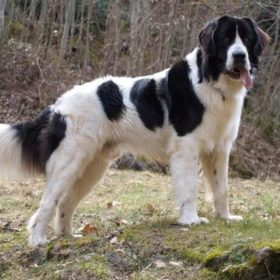 Landseer
Landseer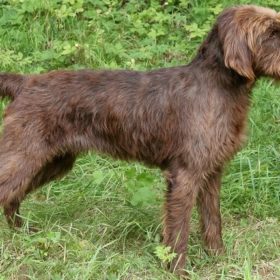 Pudelpointer
Pudelpointer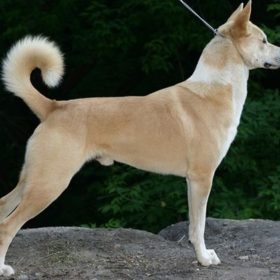 Canaan Dog
Canaan Dog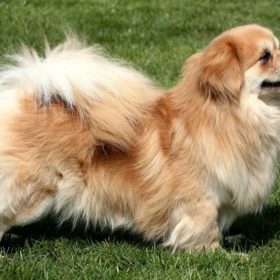 Tibetan Spaniel
Tibetan Spaniel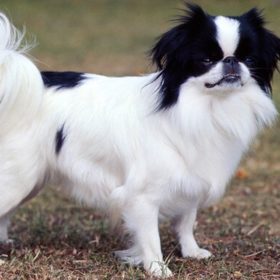 Japanese Chin
Japanese Chin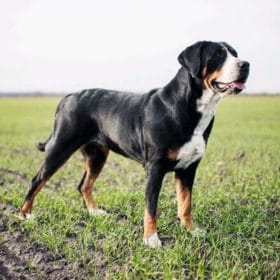 Greater Swiss Mountain Dog
Greater Swiss Mountain Dog